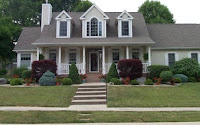If you’re like me, you like to have a yard that is beautiful, thriving, and green. That takes water. As a matter of fact, one common denominator between almost all the beautiful landscapes in central Texas is a sprinkler system. That’s because those landscape owners have discovered the best way to have a beautiful landscape is to give it enough water at the right time and a sprinkler system is the easiest way to accomplish that.
But what if the satisfaction you derive from a beautiful landscape goes down the dumper when you get your water bill? I know it’s hard to say you enjoy your beautiful landscape x dollars worth, but perhaps you have come to realize you DIDN’T enjoy it $_____ worth. (Fill in the amount of your last water bill.) If that’s the case, it’s time to take action.
Maybe it’s time to make a choice in favor of financial frugality. The professional water guys agree. Any time you look at the efficient methods of watering landscapes, you’ll run into a concept called “allowable stress”.
Allowable stress assumes that your landscape can be “good enough” without being “perfect.” What a concept! So, if your beautiful landscape carries with it a water bill that has gotten out of hand, maybe it’s time to change.
In other words, if YOU are stressed because your plants aren’t, maybe it’s time for a role reversal. Maybe it’s time for some of your grass to die––or, at least go dormant.
If that’s where you’re headed, you might want to keep in mind a couple caveats.
But what if the satisfaction you derive from a beautiful landscape goes down the dumper when you get your water bill? I know it’s hard to say you enjoy your beautiful landscape x dollars worth, but perhaps you have come to realize you DIDN’T enjoy it $_____ worth. (Fill in the amount of your last water bill.) If that’s the case, it’s time to take action.
Maybe it’s time to make a choice in favor of financial frugality. The professional water guys agree. Any time you look at the efficient methods of watering landscapes, you’ll run into a concept called “allowable stress”.
Allowable stress assumes that your landscape can be “good enough” without being “perfect.” What a concept! So, if your beautiful landscape carries with it a water bill that has gotten out of hand, maybe it’s time to change.
In other words, if YOU are stressed because your plants aren’t, maybe it’s time for a role reversal. Maybe it’s time for some of your grass to die––or, at least go dormant.
If that’s where you’re headed, you might want to keep in mind a couple caveats.
- Your landscape influences your property’s worth. Just be aware that your landscape has at least two values.
- Replacement Cost: Will it cost a lot to replace it if everything dies?
- Aesthetic Value: A pretty place is usually worth more than an ugly or unkept place and “ugly” and “dead” go together like salt and pepper.
- Establish a priority. That 100 year old oak tree is probably worthy of more trouble than that blade of grass. Water valuable trees and shrubs at the expense of lower value plants.
It doesn’t have to be all or nothing--with one possible exception. If you can lower your water bill but keep everything on life support, that’s good. But Bermudagrass is an exception. It is a very drought tolerant plant and responds to all or nothing. It does not respond well to just keeping it alive. If you have Bermudagrass and want to wait until this drought has ended, you’re probably better off depriving Bermudagrass completely--within reason.
Do your own test. Try cutting your water in half. If you water every day, cut it to every other day. If you water three times a week, use the Water Budget feature on your irrigation controller to drop is to 50% of your current settings. Look at how your landscape is responding to this diet. If all is well, you might want to cut it in half again. When you see a degradation, stop or even bring it back up a bit.
Your grass and other plants will not do as well as they did with the full meal, but your checkbook balance will notify you of your wisdom. A little bit of stress transfer might be just what’s needed.
Note: A properly maintained sprinkler system can save water, too. If Rainstat Irrigation can help, please call us at 254-829-3800.
Do your own test. Try cutting your water in half. If you water every day, cut it to every other day. If you water three times a week, use the Water Budget feature on your irrigation controller to drop is to 50% of your current settings. Look at how your landscape is responding to this diet. If all is well, you might want to cut it in half again. When you see a degradation, stop or even bring it back up a bit.
Your grass and other plants will not do as well as they did with the full meal, but your checkbook balance will notify you of your wisdom. A little bit of stress transfer might be just what’s needed.
Note: A properly maintained sprinkler system can save water, too. If Rainstat Irrigation can help, please call us at 254-829-3800.















